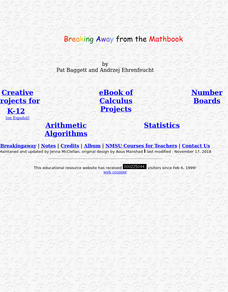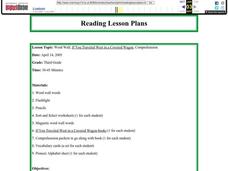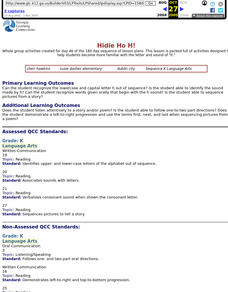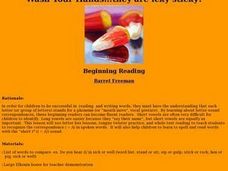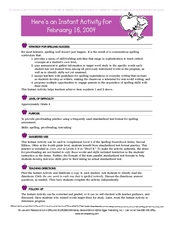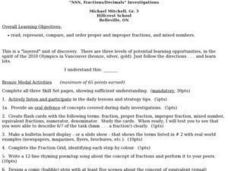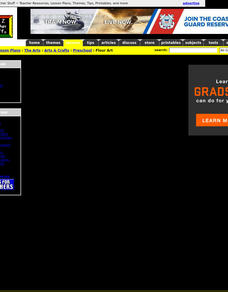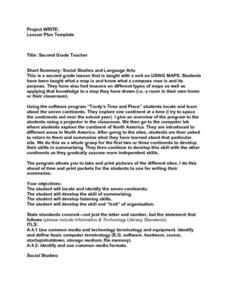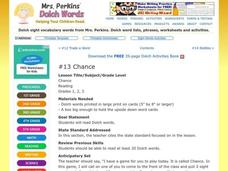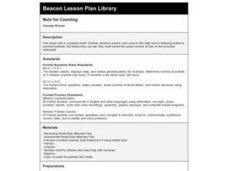Curated OER
Clocks and Time
Students construct clocks and then learn how to read a clock face, tell time, and determine how much time has elapsed.
Curated OER
Fall Slumbers
Students observe changes in a selected tree leaf near their homes during the fall. Twice each week students record changes in the leaf using words, pictures, and numbers.
Pennsylvania Department of Education
Some Special Sums
Students study addition. In this math lesson, students solve doubles and doubles plus one addition facts. Students roll dice and use the numbers to create addition problems.
Curated OER
Word Wall, If You Traveled West in a Covered Wagon
Third graders use vocabulary from "If You Traveled West in a Covered Wagon" to play a game.
Curated OER
Powers of 10
Students explore universe, and examine how big it really is and how scientists measure the distances or sizes of things by estimating sizes of different objects and reading and writing numbers in scientific notations.
Curated OER
Wild Things Are Here
Students engage in a literature study for the book Where The Wild Things Are. The skill of prediction is practiced as they preview the story as a whole class. The teacher models reading fluency, pronunciation, and phonetic skills while...
Curated OER
Lu-Lu
First graders practice their counting skills while playing a Hawaiian game called Lu-Lu. Lu-Lu is a Hawaiian counting game. It is played with four stones. Each stone is divided into four equal sections and dots are placed in the...
Curated OER
Their or There
In this language arts worksheet, learners learn when to use the words "there" and "their." Students complete 10 sentences with the correct word, either writing it in the blank or cutting and pasting word cards. The word "they're" is not...
Curated OER
Spring Awakenings
Students observe changes in a selected tree bud/leaf during spring. They record changes in the bud/leaf using words, pictures and numbers. They understand that trees adapt to changes in temperature, light, and moisture by sprouting leaves.
Curated OER
Loyalist Day
Middle schoolers interview each other to complete an interview organizer on research about Canadian Loyalists.
Curated OER
Hidie Ho H!
Students become more familiar with the letter and sound of h by using the poem, Humpty Dumpty. They are given a sequencing sheet, a pair of scissors, crayons, and a piece of construction paper and told to put pictures in the correct order.
Curated OER
Triangles Are Not Bad!
Students investigate stereotypes and diversity by performing a play about shapes entitled, "Triangles Are Not Bad!" They role play as the shapes who each feel they are superior to the rest.
Curated OER
Chirping Chickens
First graders study the /ch/ diagraph using a tongue twister which they listen to and recite. Next, they use Elkonin letterboxes to make words with the /ch/diagraph. They listen to Jean Luc-Fromental's, "Broadway Chicken" twice, the...
Curated OER
Wash Your Hands...they are icky sticky!
Learners engage in an emergent literacy lesson that focuses on phonemic awareness and they practice corresponding the letter "i" to its long or short sound. This type of recognition has been found to be essential to reading development.
Curated OER
Here's an Instant Activity for February 16, 2004
Fourth graders complete a spelling activity that also improves their proofreading skills. In this spelling lesson, 4th graders read a list of words and proofread to find the word spelled correctly in each row.
Curated OER
The Truth About Bats
Students read information about bats in an encyclopedia. They discuss the different myths associated with the animal. They answer questions about the reading passage to end the lesson.
Curated OER
100 More 100 Less
Third graders review the concept of place value and number sense. With a partner, they are given four cards with numbers on them. Using the cards, they practice making new numbers and completing addition and subtraction to find the...
Curated OER
"NSN, Fractions/Decimals" Investigations
Fifth graders engage in a "layered" unit of discovery. There are three levels of potential learning opportunities, in the spirit of the 2010 Olympics in Vancouver (bronze, silver, gold). The lesson plan is based upon fractions.
Curated OER
Counting By 5s
Second graders count by 5's to 100. In this math lesson conducted on the 100th day of school, 2nd graders use picture stamps in the KidPix program to count by 5's and get to 100.
Curated OER
Flour Art
Students create pictures using white and whole wheat flour, oatmeal, and cornmeal while learning the different types of grains used to make breads.
Curated OER
Flour Art
Students create pictures using white and whole wheat flour, oatmeal, and cornmeal while learning the different types of grains used to make breads.
Curated OER
Project WRITE
Second graders have been taught hwot o use a map. They also know about a compass and different types of maps. Students use a software program to locate and learn about the seven continents. At each continent they are to summarize what...
Curated OER
Chance
Students practice sight words using the Dolch vocabulary lists. In this sight word lesson, students are engaged in a whole class game that allows every student to practice reading Dolch words off index cards. Students then...
Curated OER
Nuts for Counting
First graders observe, predict, and count in this nutty lesson featuring boiled or parched peanuts. They use a worksheet to record the actual number of nuts.
